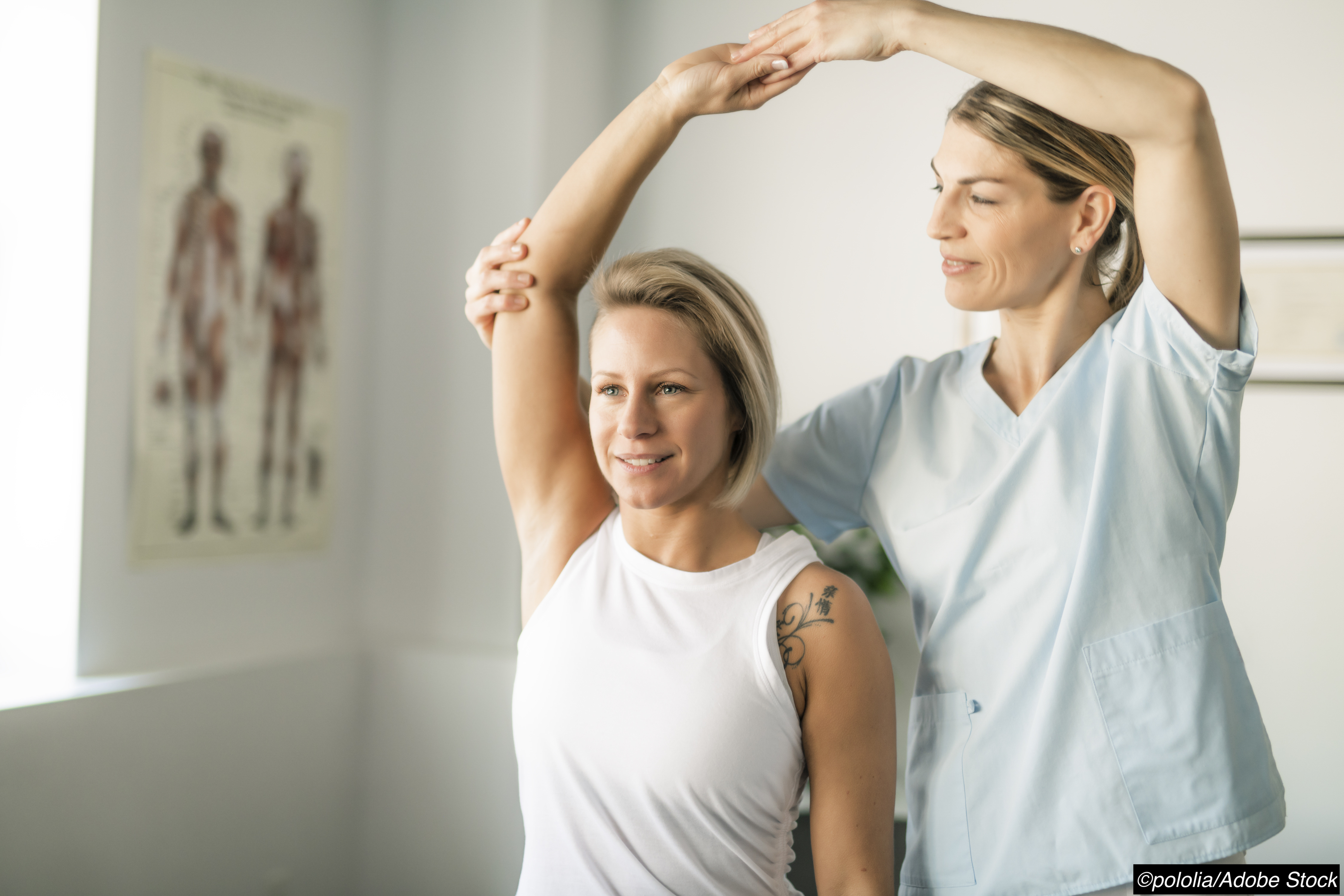
A structured exercise program for women after non-reconstructive breast cancer surgery was effective in helping to improve upper limb function compared with usual care in women at high risk of upper limb disability. Moreover, the program was cost effective.
The program, dubbed PROSPER, helped to improve upper limb function, postoperative pain, arm symptoms, and physical quality of life at 12 months. “We found that our physiotherapy led exercise program, introduced within seven to 10 days of breast cancer surgery, did not increase wound related complications, neuropathic pain, or lymphedema symptoms at one year,” Julie Bruce. PhD, Warwick Clinical Trials Unit, Division of Health Sciences, University of Warwick, Coventry, U.K., and colleagues wrote in the BMJ.
“Breast cancer treatments can affect the lymphatic and musculoskeletal systems of the torso and upper limb,” the study authors wrote. “Adverse sequelae after surgery and radiotherapy targeting the axilla are common, and up to one third of women experience restricted range of motion in the shoulder, chronic pain, and lymphedema, limiting quality of life, and delaying recovery.”
They noted that in the U.K., while NICE guidelines advise gradual reintroduction of upper limb mobility, physiotherapy is only recommended if there are problems.
But when?
” …[T]he optimal timing, intensity, safety, and impact of postoperative exercise are uncertain, particularly in women undergoing axillary clearance surgery or axillary/supraclavicular radiotherapy, who are at increased risk of developing shoulder and upper limb related disability,” Bruce and colleagues wrote.
There is uncertainty, they noted, as to whether too vigorous exercise could be harmful and increase wound complications and lymphedema. Given the dearth of research on when it is safe to introduce range of motion and strengthening exercises for this patient population, Bruce and colleagues undertook their study, which took place at 17 U.K. National Health Service cancer centers, to compare their structured U.K. Prevention of Shoulder Problems Trial (PROSPER) to usual care.
Of 951 women with invasive or non-invasive cancer recruited for the trial, 392 met the eligibility requirements for randomization, and ultimately, 191 were randomized to each arm of the trial, with 139 in the treatment arm and 139 in the non-treatment arm included in the final analysis.
Those who received usual care (non-treatment arm) were given educational information that recommended postoperative exercise, as well as other freely available advice. Those women who were randomized to the exercise program (treatment arm) received the same educational material but were also referred to physiotherapy.
“We produced a menu of upper limb exercises targeting shoulder flexion, abduction, and abduction with external rotation, from which the treating physiotherapist could prescribe an individually tailored program,” the study authors wrote. Supportive materials were also developed.
Patients met with a trained physiotherapist for at least three sessions—7-10 days, 1 month, and 3 months post-operatively. They were permitted a maximum of six sessions over the course of the year, with the ability for additional sessions either in person or by phone.
The primary outcomes measures were “Disability of Arm, Hand and Shoulder (DASH) questionnaire at 12 months, analyzed by intention to treat,” the study authors wrote. “Secondary outcomes included DASH subscales, pain, complications, health related quality of life, and resource use, from a health and personal social services perspective.”
The mean (SD) age of the participants was 58.1, and most were White.
“Overall, most participants had axillary node clearance (327/382; 86%) and/or axillary/ supraclavicular radiotherapy (317/382; 83%), and most (277/382; 73%) were overweight or obese at recruitment,” Bruce and colleagues wrote. “One fifth (83/392; 21%) had a history of shoulder problems at recruitment.”
The exercise program was well received, with 181/191 (95%) attending at least one physiotherapy appointment and 143 (75%) fully adherent, having attended three or more sessions.
“Physiotherapists had a total of 622 contacts (mean 3.7; median 3) with 181 participants who attended the exercise program; 97% (603/622) of contacts were face to face, and the remainder were telephone reviews (19/622; 3%),” Bruce and colleagues noted.
Among their findings:
- Improved upper limb functioning for the exercise group over usual care (mean DASH 16.3 [SD 17.6] for exercise [n=132]; 23.7 [22.9] usual care; adjusted mean difference 7.81, 95% confidence interval 3.17 to 12.44; P=0.001).
- In the secondary outcomes, exercise bested usual care with lower pain intensity at 12 months (adjusted mean difference on numerical rating scale −0.68, −1.23 to −0.12; P=0.02) and fewer arm disability symptoms at 12 months (adjusted mean difference on Functional Assessment of Cancer Therapy-Breast+4 [FACT-B+4] −2.02, −3.11 to −0.93; P=0.001).
- Those in the exercise group did not see an increase in complications, lymphedema, or adverse events.
- Exercise cost less and was cost effective per patient compared with usual care (on average −£387 [€457; $533] 95% confidence interval −£2491 to £1718; 2015 pricing).
The study authors admit there are limitations to the study, including lack of objective measurements for the secondary outcomes; that physiotherapists and patients were not masked to the treatment; and that the economic analysis was done on a subset of participants, and was possibly not representative of the whole sample.
-
A structured, cost-effective exercise program for women after non-reconstructive breast cancer surgery was effective in helping to improve upper limb function in women at high risk of upper limb disability compared with women who were randomized to usual care.
-
The program helped to improve upper limb function, postoperative pain, arm symptoms, and physical quality of life at 12 months, and did not increase wound related complications, neuropathic pain, or lymphedema symptoms.
Candace Hoffmann, Managing Editor, BreakingMED™
Funding for this study was received from the UK National Institute for Health Research (NIHR) Health Technology Assessment Programme project.
Bruce received grants from the UK NIHR during the conduct of this study and is a member of the NIHR Research for Patient Benefit board.
Cat ID: 22
Topic ID: 78,22,730,22,691,192,925,162


